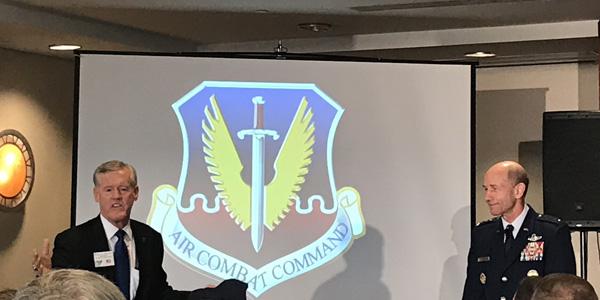The Air Force Sets Its Scope on Information Warfare
The U.S. Air Force is in the process of standing up a new Numbered Air Force (NAF) within the Air Combat Command, which will bring together the service’s information warfare capabilities.
Last year, the service announced it was moving its 24th Air Force, which specializes in cyber operations, and its Cyber Mission from the Air Force Space Command to the Air Combat Command. The Air Combat Command (ACC) is in the process of merging those cyber components with its intelligence, surveillance and reconnaissance (ISR) capabilities from the 25th Air Force, which will all be under the new Information Warfare NAF, explained Gen. Mike Holmes, USAF, commander, ACC during an Air Force Association breakfast event on August 23.
The restructuring also brings into the new NAF the 557th Weather Wing from the 12th Air Force. The wing provides key weather intelligence to the U.S. military, the federal government and allies, and will be better suited at the Information Warfare NAF, the general opined.
The ACC is working through the nomination process for the new NAF, approval of which they hope to get this fall from Air Force headquarters, the commander said. “We'll start off with the consolidated component NAF, with an integrated staff and a single operation center that ties those things together,” Gen. Holmes noted. “We can do that at IOC [initial operational capability] this fall and then we'll continue to stretch and build on that information warfare, information ops [operations] capability that we provide through service and cyber components.”
The reasoning behind the new NAF is to generate a decisive information advantage, Gen. Holmes said.
“Our belief is that it will make us more effective across this information spectrum,” he said. “We are in a competition with our adversaries that has a military component that largely stays below the level of armed conflict, and we'd like to keep it there. And so, we want to recast that competition on terms that are favorable for us. Part of that is offering options to our national decision makers that they can use in competition that are not necessarily escalatory but are on the right level with things that our adversaries are doing.”
For whoever will lead the new Information Warfare NAF, it will be a tough undertaking, Gen. Holmes acknowledged. “This is a big job, what we're going to ask this new numbered Air Force commander to do, but it's important, we think, to bring these capabilities together.”
The yet-to-be-named commander will lead everything related to Air Force cyber, the general said. The commander will be the service component to the U.S. Cyber Command (CYBERCOM), with cyber mission defense teams supporting that role. The commander will lead the Joint Force Headquarters Cyber Air Force, which focuses on supporting several of the Combatant Commands (COCOMS), including the U.S. European Command, U.S. Transportation Command and U.S. Strategic Command.
The new Information Warfare NAF commander “will be the Air Force Net Ops [network operations] crew manager, so he'll also run all the networks that the Air Force provides, both at the unclassified, secret and higher classification levels,” Gen. Holmes continued. “He would be our service cryptologic component commander, working to support any airmen that we provide to the National Security Agency and the other things that we do across the intelligence community.”
“We'll be pulling all that together, supporting both U.S. CYBERCOM and the Air Force's cyber role, and continuing to support the rest of the COCOMS with global integrated intelligence, surveillance and reconnaissance,” he stated.





Comments